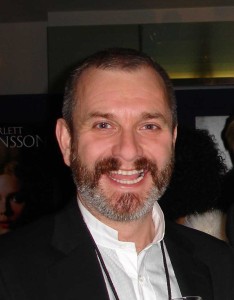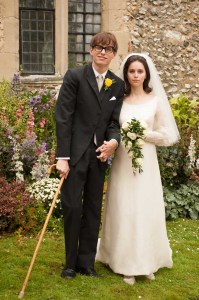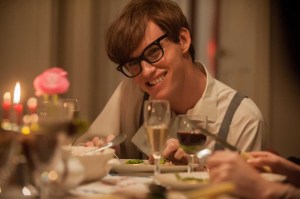![]()

The task of discovering the world where the Hawkings lived and recreating it for the film belonged to Kelly. His period research was aimed at the historical recreation of the principals’ lives. Jane Hawking sent him source material – photographs from when they were younger and Super-8 footage of Hawking and the children in their garden – that served as inspiration for how the family lived and gave Kelly an essence of their lives.
“All of us decided early on that the film required a sensitivity and a gentleness, and I suppose a subtlety, which is very evident in Eddie and Felicity’s performances,” Kelly said. “The film travels through 40 years, but you are in this academic world that doesn’t change very much.”
A major part of Kelly’s job was to deal with the passage of time in an interesting way that did not jar. Even as Hawking’s disability became more evident, shutting down the world inside him, the outside world was expanding. “Those are the themes we picked up really early and wanted to play with,” revealed Kelly.

For the subtle changes over time to work, Kelly collaborated closely with costume designer, Steven Noble, and make-up/hair designer, Jan Sewell. They put everything on walls and ascertained where a major change would happen and which department would enact a change.
“If there was a new hair style, there wouldn’t be new wallpaper. That way things gradually changed,” Kelly said. “Things got bigger, but things also got more modern as you moved through. What’s lovely about the story in terms of narrative, if we did our job properly, is that you almost don’t notice those transitions. Then at the end of the film, when you have that reverse sequence of his life, you see the passage back through time.
The production had quite a few practical challenges. Due to logistics, such as crewing the film in Cambridge while students were at the school, the company had one week to film on location, so they could only film the college exteriors and the May Ball sequence, which was a complicated set-piece to achieve during the scheduled two days. Most of the interiors either had to be built on stage or be shot at locations in London.
 Kelly’s favorite set was the classroom where Hawking came up with the idea for his thesis. The team thought long and hard about how this classroom, that would normally be uninteresting, would appear. “I fell in love with these fantastic equations,” Kelly disclosed. “None of us had a clue what they meant, these brilliant equations physicists wrote on blackboards. We came up with this idea of building a tunnel of blackboards. We built a room completely made of blackboards so the whole scene is him, with the camera moving past equation after equation to end up on the blackboard at the end where Penrose is giving his lecture.” For Kelly, that set presented in a visual way the essence of being inside the head of a physicist dreaming up an equation.
Kelly’s favorite set was the classroom where Hawking came up with the idea for his thesis. The team thought long and hard about how this classroom, that would normally be uninteresting, would appear. “I fell in love with these fantastic equations,” Kelly disclosed. “None of us had a clue what they meant, these brilliant equations physicists wrote on blackboards. We came up with this idea of building a tunnel of blackboards. We built a room completely made of blackboards so the whole scene is him, with the camera moving past equation after equation to end up on the blackboard at the end where Penrose is giving his lecture.” For Kelly, that set presented in a visual way the essence of being inside the head of a physicist dreaming up an equation.
Other than the span of years, the biggest challenge was the Rutherford laboratory where the atom was split and Hawking has the eureka moment that suggested his place in physics. Even when Hawking saw the laboratory in the early ’60s, the room was an antiquated time capsule. Given its historical significance, the filmmakers hoped that it still existed. Unfortunately, they discovered the area had been turned into offices in the ’70s. When recreating the space and trying to figure out the scientific instruments it would contain, Kelly’s team learned there was surprisingly little research material on the room.
“Then we found this great Pathé newsreel footage of the lab, which was fantastic, so we used that for our basis,” said Kelly. “It was kind of a magical science moment, one of the few times that the science is more than just an equation.” The scene was a pivotal moment in the film in which Hawking’s restricted world expanded into a universe of possibilities. It was a world that Kelly helped to build through collaboration and imagination.





